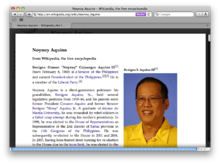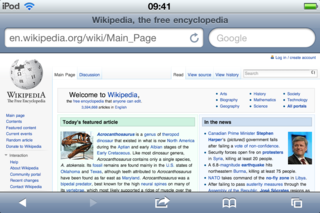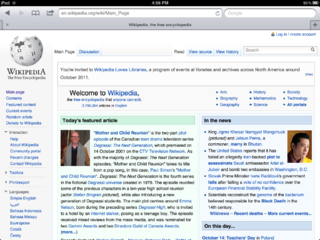- Safari (web browser)
-
Safari 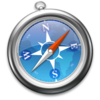
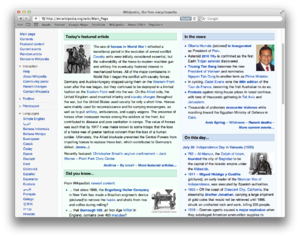
Safari 5.1 on Mac OS X LionDeveloper(s) Apple Inc. Initial release January 7, 2003 Stable release 5.1.1 (October 12, 2011)[1] [+/−] Preview release 5.1.2 (November 3, 2011)[2] [+/−] Written in C++,[3] Objective-C Operating system Mac OS X Snow Leopard and Lion
Windows XP, Vista, and 7
iOSEngine WebKit (Based on KHTML) Development status Active Type Web browser License Proprietary; some components GNU LGPL Website apple.com/safari Safari is a web browser developed by Apple Inc. and included with the Mac OS X and iOS operating systems. First released as a public beta on January 7, 2003[4] on the company's Mac OS X operating system, it became Apple's default browser beginning with Mac OS X v10.3 "Panther". Safari is also the native browser for iOS. A version of Safari for the Microsoft Windows operating system, first released on June 11, 2007, supports Windows XP, Windows Vista, and Windows 7.[5] The latest stable release of the browser is 5.1.1, which is available as a free download for both Mac OS X and Microsoft Windows. As of October 2011, Safari accounts for 62.17 percent of mobile traffic, although the desktop version accounts for only 8.72 percent of desktop web browsing traffic. Safari is the fourth most popular web browser, behind Internet Explorer (49.6 percent), Mozilla Firefox (21.20) and Google Chrome (16.60).[6]
Contents
History and development
See also: Safari version historyUntil 1997, Apple Macintosh computers were shipped with the Netscape Navigator and Cyberdog web browsers only. Internet Explorer for Mac was later included as the default web browser for Mac OS 8.1 and onwards,[7] as part of a five year agreement between Apple and Microsoft. During that time, Microsoft released three major versions of Internet Explorer for Mac that were bundled with Mac OS 8 and Mac OS 9, though Apple continued to include Netscape Navigator as an alternative. Microsoft ultimately released a Mac OS X edition of Internet Explorer for Mac, which was included as the default browser in all Mac OS X releases from Mac OS X DP4[8] until Mac OS X v10.2.[9]
Safari 1
On January 7, 2003, at Macworld San Francisco, Steve Jobs announced that Apple had developed their own web browser, called Safari. It was based on Apple's internal fork of the KHTML rendering engine, called WebKit.[10] Apple released the first beta version for OS X that day. A number of official and unofficial beta versions followed, until version 1.0 was released on June 23, 2003. Initially only available as a separate download for Mac OS X v10.2, it was included with the Mac OS X v10.3 release on October 24, 2003 as the default browser, with Internet Explorer for Mac included only as an alternative browser. 1.0.3, released on August 13, 2004 was the last version to support Mac OS X v10.2, while 1.3.2, released on January 12, 2006 was the last version to support Mac OS X v10.3. However, 10.3 received security updates through 2007.
Safari 2
In April 2005, Dave Hyatt, one of the Safari developers at Apple, documented his progress in fixing specific bugs in Safari, thereby enabling it to pass the Acid2 test developed by the Web Standards Project. On April 27, 2005, he announced that his development version of Safari now passed the test, making it the first web browser to do so.[11]
Safari 2.0 was released on April 29, 2005 as the only web browser included with Mac OS X v10.4. This version was touted by Apple as possessing a 1.8x speed boost over version 1.2.4, but did not yet include the Acid2 bug fixes. The necessary changes were not initially available to end-users unless they downloaded and compiled the WebKit source code themselves or ran one of the nightly automated builds available at OpenDarwin.org.[12] Apple eventually released version 2.0.2 of Safari, which included the modifications required to pass Acid2, on October 31, 2005.
In June 2005, after some criticism from KHTML developers over lack of access to change logs, Apple moved the development source code and bug tracking of WebCore and JavaScriptCore to OpenDarwin.org. WebKit itself was also released as open source. The source code for non-renderer aspects of the browser, such as its GUI elements, remains proprietary.
The final stable version of Safari 2, Safari 2.0.4, was released on January 10, 2006 for Mac OS X. It was only available as part of Mac OS X Update 10.4.4. This version addresses layout and CPU usage issues, among others.[13] Safari 2.0.4 was the last version to be released exclusively on Mac OS X.
Safari 3
On January 9, 2007, at Macworld SF, Jobs announced Apple's iPhone, which would use a mobile version of the Safari browser.[14]
On June 11, 2007, at the Apple Worldwide Developers Conference, Jobs announced Safari 3 for Mac OS X v10.5, Windows XP, and Windows Vista. During the announcement, he ran a benchmark based on the iBench browser test suite comparing the most popular Windows browsers,[15] hence claiming that Safari was the fastest browser. Later third-party tests of HTTP load times would support Apple's claim that Safari 3 was indeed the fastest browser on the Windows platform in terms of initial data loading over the Internet, though it was found to be only negligibly faster than Internet Explorer 7 and Mozilla Firefox when loading static content from local cache.[16]
The initial Safari 3 beta version for Windows, released on the same day as its announcement at WWDC 2007, had several known bugs[17] and a zero day exploit that allowed remote execution.[18] The addressed bugs were then corrected by Apple three days later on June 14, 2007, in version 3.0.1 for Windows. On June 22, 2007, Apple released Safari 3.0.2 to address some bugs, performance issues and other security issues. Safari 3.0.2 for Windows handles some fonts that are missing in the browser but already installed on Windows computers, such as Tahoma, Trebuchet MS, and others.
The iPhone was formally released on June 29, 2007. It includes a version of Safari based on the same WebKit rendering engine as the desktop version, but with a modified feature set better suited for a mobile device. The version number of Safari as reported in its user agent string is 3.0,[19] in line with the contemporary desktop versions of Safari.
The first stable, non-beta release of Safari for Windows, Safari 3.1, was offered as a free download on March 18, 2008. In June 2008, Apple released version 3.1.2,[20][21] addressing a security vulnerability in the Windows version where visiting a malicious web site could force a download of executable files and execute them on the user's desktop.[22]
Safari 3.2, released on November 13, 2008, introduced anti-phishing features and Extended Validation Certificate support. The final version of Safari 3 is 3.2.3, released on May 12, 2009.
Safari 4
On June 2, 2008, the WebKit development team announced SquirrelFish,[23] a new JavaScript engine that vastly improves Safari's speed at interpreting scripts.[24] The engine is one of the new features in Safari 4, released to developers on June 11, 2008. The new JavaScript engine quickly evolved into SquirrelFish Extreme, featuring even further improved performance over SquirrelFish,[25] and was eventually marketed as Nitro. A public beta of Safari 4 was released on February 24, 2009, with new features such as the Top Sites tool (similar to Opera's Speed Dial feature), which displays the user's most visited sites on a 3D wall.[26] Cover Flow, a feature of Mac OS X and iTunes, was also implemented in Safari. In the public beta versions, tabs were placed in the title bar of the window, similar to Google Chrome. The tab bar was moved back to its original location, below the URL bar, in the final release.[27] The Windows version adopted a native Windows theme, rather than the previously employed Mac OS X-style interface. Also Apple removed the blue progress bar located in the address bar (later reinstated in Safari 5). Safari 4.0.1 was released for Mac on June 17 and fixed problems with Faces in iPhoto '09. Safari 4 in Mac OS X v10.6 "Snow Leopard" has 64-bit support, which can make JavaScript loading up to 50% faster. It also has built-in crash resistance unique to Snow Leopard; crash resistance will keep the browser intact if a plug-in like Flash player crashes, such that the other tabs or windows will be unaffected.[28] Safari 4.0.4, released on November 11, 2009 for both OS X and Windows, further improves JavaScript performance.[29]
Safari was one of the twelve browsers offered to EU users of Microsoft Windows in 2010. It is also one of the five browsers displayed on the first page of browser choices along with Chrome, Firefox, Internet Explorer and Opera.[30][31]
Safari 5
Apple released Safari 5 on June 7, 2010, featuring the new Safari Reader for reading articles on the web without distraction (based on Arc90's Readability tool[32]), and a 30 percent Javascript performance increase over Safari 4. Safari 5 includes improved developer tools and supports more than a dozen new HTML5 technologies, focused on interoperability. With Safari 5, developers can now create secure Safari Extensions to customize and enhance the browsing experience.[33] Apple also re-added the progress bar behind the address bar in this release. Safari 5.0.1 enabled the Extensions PrefPane by default; previously, users had to enable it via the Debug menu.
Apple also released Safari 4.1 concurrently with Safari 5, exclusively for Mac OS X Tiger. The update included the majority of the features and security enhancements found in Safari 5. It did not, however, include Safari Reader or Safari Extensions. Together with Mac OS X 10.7 Lion, Apple released Safari 5.1 for both Windows and Mac on July 20, 2011, with the new function 'Reading List' and a faster browsing experience. Apple simultaneously released Safari 5.06 for Mac OS X 10.5 Leopard, excluding Leopard users from the new functions in Safari 5.1.
WebKit2
On April 9, 2010, Apple announced WebKit2.[34] This was integrated into Safari as of version 5.1.[35]
"WebKit2 is designed from the ground up to support a split process model, where the Web content (JavaScript, HTML, layout, etc) lives in a separate process," wrote Apple developer Anders Carlsson to WebKit's public mailing list on April 8, 2010. "This model is similar to what Google Chrome offers, with the major difference being that we have built the process split model directly into the framework, allowing other clients to use it."[34]
The "process split" model to which Carlsson refers is the architecture that enables processes spawned by the browser, including add-ons and Web apps, to be run as separate processes in the operating system while still being protected by the browser's sandbox. Google's Chromium team developed the first such model in working form for its Chrome browser.[36][37]
Features
Safari offers numerous features, including:
- Ability to save webpage clips for viewing on the Apple Dashboard (Mac OS X only)
- A resizable web-search box in the toolbar which allows choice among Google, Yahoo! or Bing only
- Automatic filling in of web forms ("autofill")
- Bookmark integration with Address Book
- Bookmark management
- Built-in password management via Keychain (Mac OS X only)
- History and bookmark search
- Expandable text boxes
- ICC color profile support
- Inline PDF viewing (Mac OS X only)
- iPhoto integration (Mac OS X only)
- Mail integration (Mac OS X only)
- Pop-up ad blocking
- Private browsing
- Quartz-style font smoothing
- Reader mode, for viewing an uncluttered version of Web articles
- Spell checking
- Subscribing to and reading web feeds
- Support for CSS 3 web fonts
- Support for CSS animation
- Support for HTML5
- Support for Transport Layer Security protocol (version unknown)
- Tabbed browsing
- Text search
- Web Inspector, a DOM Inspector-like utility that lets users and developers browse the Document Object Model of a web page[38]
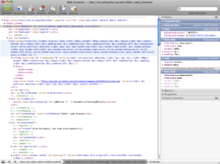 Safari's Web Inspector, showing the DOM tree for this page.
Safari's Web Inspector, showing the DOM tree for this page.
On Mac OS X, Safari is a Cocoa application.[39] It uses Apple's WebKit for rendering web pages and running JavaScript. WebKit consists of WebCore (based on Konqueror's KHTML engine) and JavaScriptCore (originally based on KDE's JavaScript engine, named KJS). Like KHTML and KJS, WebCore and JavaScriptCore are free software and are released under the terms of the GNU Lesser General Public License. Some Apple improvements to the KHTML code are merged back into the Konqueror project. Apple also releases additional code under an open source 2-clause BSD-like license.
It includes a built-in web feed aggregator that supports the RSS and Atom standards. Other features include Private Browsing (a mode in which no record of information about the user's web activity is retained by the browser),[40] the ability to archive web content in the proprietary Webarchive format, the ability to e-mail complete web pages directly from a browser menu, and the ability to search bookmarks.
New features in Safari 4
Beginning with Safari 4, the address bar has been completely revamped:
- The blue inline progress bar is replaced with a spinning bezel and a loading indicator attached to it.
- The button to add a bookmark is now attached to the address bar by default.
- The reload/stop button is now superimposed on the right end of the address bar.
These modifications make Safari on Mac OS X and Windows look more similar to Safari on iPhone than previous versions.
Safari 4 also includes the following new features:
- Completely passes the Acid3 standards test
- Cover Flow browsing for History and Bookmarks
- Improved developer tools, including Web Inspector, CSS element viewing, JavaScript debugger and profiler, offline table and database management with SQL support, and resource graphs
- Nitro JavaScript engine that executes JavaScript up to eight times faster than Internet Explorer 8 and more than four times faster than Firefox 3[41]
- Native Windows look on Windows (Aero, Luna, Classic, etc., depending on OS and settings) with standard Windows font rendering and optional Apple font rendering
- Support for CSS image retouching effects
- Support for CSS Canvas
- Speculative loading, where Safari loads the documents, scripts, and style information that are required to view a web page ahead of time
- Support for HTML5
- Top Sites, which displays up to 24 thumbnails of a user's most frequently-visited pages on startup
New features in Safari 5
-
This list is incomplete; you can help by expanding it.
Safari 5 includes the following new features:
- Full-text search through the browser history[42]
- Safari Reader, which removes formatting and ads from webpages.[43]
- Smarter address field, where the address bar autocomplete will match against titles of web page in history or bookmarks.
- Extensions, which are add-ons that customize the web browsing experience.[44]
- Improved support for HTML5, including full screen video, closed caption, geolocation, EventSource, and WebSocket.
- Improved Web Inspector.
- Faster Nitro Javascript Engine.
- DNS prefetching, where Safari finds links and looks up addresses on the web page ahead of time.
- Bing search.
- Improved graphics hardware acceleration on Windows.
Additionally, the blue inline progress bar has returned to the address bar, in addition to the spinning bezel and loading indicator introduced in Safari 4. Top Sites view now has a button to switch to Full History Search. Other features include Extension builder for developers of Safari Extensions, which are built using web standards such as HTML5, CSS3, and Javascript.
iOS-specific features
iOS-specific features for Safari enable:
- Bookmarking links to particular pages as "Web Clip" icons on the Home screen.[citation needed]
- MDI-style browsing (with up to 8 pages open concurrently, limited by cache storage).[citation needed]
- Opening specially-designed pages in full-screen mode.[citation needed]
- Pressing on an image for 3 seconds to save it to the photo album.[citation needed]
- Support for HTML5 new input types.[citation needed]
New in iOS 4.2
New in iOS 4.3
- Integration of the Nitro JavaScript engine for faster page loads (only available to iPhone 3GS, 3rd Generation iPod Touch, iPad and above) This feature was discovered to only work in the MobileSafari app, and not in the integrated viewer that many apps use.
New in iOS 5
- True tabbed browsing, similar to the desktop experience, only for the iPad and iPad 2.[47]
- Reading List, a bookmarking feature that allows tagging of certain sites for reading later, which syncs across all Safari browsers (mobile and desktop) via Apple's iCloud service.[48]
- Reader, a reading feature that can format text and images from a web page into a more readable format, similar to a PDF document, while stripping out web advertising and superfluous information.[49]
System requirements
Safari 5.1 requires either a Mac running Mac OS X v10.6.8, or a PC running Windows XP SP2, Windows Vista, or Windows 7. Official minimum hardware requirements for Windows state a 500 MHz Pentium processor with 256 MB of RAM for Windows. Cover Flow and Top Sites require a graphics card that is Quartz Extreme-compatible with 16 MB or more video memory for Mac or DirectX 9-compatible with 64 MB or more video memory for Windows.[50]
Safari 5.0.6 requires a Mac running on Mac OS X 10.5.8.[51]
64-bit builds
The version of Safari included in Mac OS X v10.6 is now compiled for 64-bit architecture. Apple claims that running Safari in 64-bit mode will increase rendering speeds by up to 50%.
Criticism
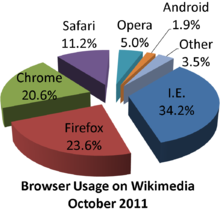 Web browser usage on Wikimedia servers
Web browser usage on Wikimedia servers
Distribution through Apple Software Update
An earlier version of Apple Software Update (bundled with Safari, QuickTime, and iTunes for Microsoft Windows) selected Safari for installation from a list of Apple programs to download by default, even when a pre-existing installation of Safari was not detected on a user's machine. John Lilly, CEO of Mozilla, stated that Apple's use of its updating software to promote its other products was "a bad practice and should stop." He argued that the practice "borders on malware distribution practices" and "undermines the trust that we're all trying to build with users."[52] Apple spokesman Bill Evans responded to Lilly's statement, saying that Apple was only "using Software Update to make it easy and convenient for both Mac and Windows users to get the latest Safari update from Apple."[53] Apple also released a new version of Apple Software Update that puts new software in its own section, though still selected for installation by default.[54] In a newer update, Apple Software Update no longer selected new installation items in the new software section by default (as of late 2008).[citation needed]
On September 22, 2009, Apple once again checked "Install Safari 4" as a default setting with their update to iTunes v9.0.1.[citation needed]
Browser exploits
In the PWN2OWN contest at the 2008 CanSecWest security conference in Vancouver, British Columbia, a successful exploit of Safari caused Mac OS X to be the first OS to fall in a hacking competition. Participants competed to find a way to read the contents of a file located on the user's desktop, in one of three operating systems: Mac OS X Leopard, Windows Vista SP1, and Ubuntu 7.10. On the second day of the contest, when users were allowed to physically interact with the computers (the prior day permitted only network attacks), Charlie Miller compromised Mac OS X through an unpatched vulnerability of the PCRE library used by Safari.[55] Miller had been aware of the flaw prior to the beginning of the conference and worked to exploit it unannounced, as is the common approach in these contests.[55] The exploited vulnerability was patched in Safari 3.1.1, among other flaws.[56]
In the 2009 PWN2OWN contest, Charlie Miller performed another successful exploit of Safari to hack into a Mac. Miller again acknowledged that he had advance knowledge of the security flaw prior to the competition, and had done considerable research and preparation work on the exploit.[57][58] Apple released a patch for this exploit and others on May 12, 2009 with Safari 3.2.3.[59][60]
Software license agreement
The original software license agreement for Safari on Windows was unusually restrictive for several months,[61] reading in part:
This License allows you to install and use one copy of the Apple Software on a single Apple-labeled computer at a time.[62]
As most personal computers running Windows are not Apple-labeled computers, it was impossible for most Windows users to use the software and abide by the license agreement, with the exception of Intel-based Mac computers running Windows. Within hours of the story breaking about the long-unnoticed anomaly, Apple changed the agreement as posted on their website to read:[62]
This license allows you to install and use one copy of the Apple Software on each computer owned or controlled by you.[63]
However, the Safari installer was not immediately updated and still contained the old license.[64] Later installers include corrected copies of the license.
Malware Blocking
In recent analysis, the stable version of Safari blocked 13% of malicious URLS. In contrast, Internet Explorer 9 blocked 92% of malware with its URL-based filtering, and a full 100% with Application-based filtering enabled. Internet Explorer 8, in second place, blocked 90% of malware..[65][66]
See also
- Browsers that pass Acid3
- Comparison of feed aggregators
- Comparison of web browsers
- Cyberdog, Apple's OpenDoc-based Internet suite
- iOS, Apple's mobile operating system that includes a version of Safari built-in
- List of feed aggregators
- Month of Bugs
- Safari version history
- WebKit, underlying engine of Safari and other web browsers
References
- ^ Safari 5.1.1 - Changelog - Softpedia, October 12th, 2011, http://mac.softpedia.com/progChangelog/Safari-Changelog-25616.html
- ^ "Safari 5.1.2 beta seeded to developers, includes PDF viewing bug fixes", Apple Intelligence (9to5Mac.com), November 3, 2011 at 5:15 pm, http://9to5mac.com/2011/11/03/safari-5-2-1-beta-seeded-to-developers-includes-pdf-viewing-bug-fixes/
- ^ "The WebKit Open Source Project". http://webkit.org/coding/coding-style.html.
- ^ "Apple Unveils Safari" (Press release). Apple Inc.. 2007-01-07. http://www.apple.com/pr/library/2003/jan/07safari.html. Retrieved 2008-01-03.
- ^ "Apple Introduces Safari for Windows" (Press release). Apple Inc.. 2007-06-11. http://www.apple.com/pr/library/2007/06/11safari.html. Retrieved 2008-06-12.
- ^ "Internet Explorer's share of web traffic drops below 50%". November 3, 2011. http://edition.cnn.com/2011/11/03/tech/web/internet-explorer-traffic-share-mashable/index.html.
- ^ "Mac OS 8.1 Update Document and Software". Apple Inc.. 2003-08-14. http://docs.info.apple.com/article.html?artnum=30345#English. Retrieved 2009-06-10.
- ^ "Apple Releases Mac OS X Developer Preview 4 with Final API Specs". Apple Inc.. 2000-05-15. http://www.apple.com/pr/library/2000/may/15macosx.html. Retrieved 2009-06-10.
- ^ "Java 1.3.1 for Mac OS X version 10.2 Release Notes". developer.apple.com. Apple Inc.. 2002-07. http://developer.apple.com/releasenotes/Java/Java131MOSX10.2RN/applets/chapter_2_section_2.html. Retrieved 2009-06-10.
- ^ Pour, Andreas (2003-01-07). "Apple Announces New "Safari" Browser". KDE Dot News. http://dot.kde.org/1041971213/. Retrieved 2006-01-04.
- ^ Hyatt, Dave (2005-04-27). "Safari Passes the Acid2 Test". Surfin' Safari. MozillaZine. http://weblogs.mozillazine.org/hyatt/archives/2005_04.html. Retrieved 2005-04-28.
- ^ Hyatt, Dave (2005-10-12). "Nightly Builds". Surfin' Safari. OpenDarwin.org. http://webkit.org/blog/29/nightly-builds/. Retrieved 2006-10-29.
- ^ About the Mac OS X 10.4.4 Update (Delta)
- ^ Apple Reinvents the Phone with iPhone
- ^ Wilton-Jones, Mark. "Is Safari faster?". http://www.howtocreate.co.uk/safaribenchmarks.html. Retrieved 2008-06-12.
- ^ Czeiszperger, Michae (2007-10-20). "Safari 3 Windows Performance Analysis". Web Performance. http://www.webperformanceinc.com/library/reports/Safari%20Benchmarks/index.html. Retrieved 2007-07-24.
- ^ Maynor, David (2007-06-11). "Niiiice...". Errata Security. http://erratasec.blogspot.com/2007/06/niiiice.html. Retrieved 2008-06-12.
- ^ Larholm, Thor (2007-06-12). "Safari for Windows, 0day exploit in 2 hours". http://larholm.com/2007/06/12/safari-for-windows-0day-exploit-in-2-hours/. Retrieved 2008-06-12.
- ^ Mobile Safari
- ^ About the security content of Safari 3.1.2 for Windows
- ^ Keizer, Gregg. Apple does about-face, fixes Safari's 'carpet bomb' bug, ComputerWorld (June 19, 2008).
- ^ "Microsoft Security Advisory (953818)". Microsoft. http://www.microsoft.com/technet/security/advisory/953818.mspx.
- ^ Garen, Geoffrey (2008-06-02). "Announcing SquirrelFish". http://webkit.org/blog/189/announcing-squirrelfish/. Retrieved 2008-06-11.
- ^ Lipskas, Vygantas (2008-06-11). "Apple Safari 4". http://www.favbrowser.com/apple-safari-4/. Retrieved 2008-06-11.
- ^ Introducing SquirrelFish Extreme
- ^ Hands on: Safari 4 beta fast, mixes polish, rough UI edges
- ^ Dempsey, James (2009-06-09). "Apple Releases Safari 4". TheAppleBlog. The GigaOM Network. http://theappleblog.com/2009/06/08/apple-releases-safari-4/. Retrieved 2009-06-09.
- ^ Apple - Mac OS X - What is Mac OS X - Safari
- ^ Safari 4.0.4
- ^ "Microsoft offers browser choices to Europeans". BBC. March 1, 2010. http://news.bbc.co.uk/1/hi/technology/8537763.stm. Retrieved March 1, 2010.
- ^ Peter Bright (February 19, 2010). "Microsoft's EU browser ballot approved, arrives March 1". Ars Technica. Condé Nast. http://arstechnica.com/microsoft/news/2010/02/microsofts-eu-browser-ballot-approved-arrives-march-1.ars. Retrieved March 1, 2010.
- ^ Rich Ziade (June 7, 2010). "Safari 5: Another Step Towards Better Reading On The Web". http://blog.arc90.com/2010/06/07/safari-5-another-step-towards-better-reading-on-the-web. Retrieved 2010-06-08.
- ^ Apple (2010). "Apple Releases Safari 5". http://www.prnewswire.com/news-releases/apple-releases-safari-5-95812499.html. Retrieved 2010-12-09.
- ^ a b "Announcing WebKit2". Anders Carlsson. https://lists.webkit.org/pipermail/webkit-dev/2010-April/012235.html. Retrieved April 10, 2010.
- ^ "Source code repository for public parts of Safari 5.1". The WebKit Open Source Project. http://trac.webkit.org/browser/releases/Apple/Safari%205.1/WebKit2?rev=91373. Retrieved July 20,2011.
- ^ "Multi-process Architecture". Charlie Reis. September 11, 2008. http://blog.chromium.org/2008/09/multi-process-architecture.html. Retrieved April 10, 2010.
- ^ Chromium Developer Documentation. "Process Models". http://dev.chromium.org/developers/design-documents/process-models. Retrieved April 10, 2010.
- ^ Hatcher, Timothy. "Introducing the Web Inspector". http://webkit.org/blog/41/introducing-the-web-inspector/. Retrieved 2007-06-20.
- ^ Apple Developer Connection: "What Is Cocoa?" ("Most of the applications you see on Mac OS X and iPhone OS, including Mail and Safari, are Cocoa applications."). Accessed 2009-08-19.
- ^ "Safari's private (porn) browsing mode". lifehacker. 4 May 2005. http://lifehacker.com/#!102146/safaris-private-porn-browsing-mode. Retrieved 2008-10-14.
- ^ What's new in Safari 4.
- ^ "Apple Releases Safari 5… with Extensions!". The Next Web. 8 June 2010. http://thenextweb.com/apple/2010/06/08/breaking-apple-releases-safari-5/. Retrieved 28 October 2010.
- ^ [1]
- ^ [2]
- ^ "Apple releases iOS 4.2 with free Find My Phone for some". Ars Technica. Condé Nast. 22 November 2010. http://arstechnica.com/apple/news/2010/11/apple-releases-ios-42-with-free-find-my-phone-for-some.ars. Retrieved 29 November 2010.
- ^ Apple AirPrint Product Page
- ^ [3]
- ^ [4]
- ^ [5]
- ^ Download Safari 5.1
- ^ Safari 5.0.6 for Leopard
- ^ LaMonica, Martin (2008-03-21). "Mozilla CEO says Apple's Safari auto-update 'wrong'". CNET Networks. http://news.cnet.com/8301-17939_109-9901006-2.html. Retrieved 2008-06-12.
- ^ Apple Distributes Safari Via Software Update
- ^ Keizer, Gregg (2008-04-17). "Apple makes minor concession on pushing Safari to Windows users". Computerworld (IDG). http://www.computerworld.com/action/article.do?command=viewArticleBasic&articleId=9078738. Retrieved 2008-04-19.
- ^ a b McMillan, Robert (2008-04-22). "Mac hack contest bug had been public for a year". Network World (IDG). http://www.networkworld.com/news/2008/042208-mac-hack-contest-bug-had.html. Retrieved 2008-06-12.
- ^ Update: Apple patches Safari's $10,000 bug, fixes other flaws
- ^ Pwn2Own winner says Macs are more safe, though less secure
- ^ "Charlie Miller Wins Pwn2Own Again Thanks to Safari Flaw". 2009-03-19. http://news.softpedia.com/news/Charlie-Miller-Wins-Pwn2Own-Again-Thanks-to-Safari-Flaw-107269.shtml.
- ^ "About the security content of Safari 3.2.3". Apple Inc.. 2009-05-12. http://support.apple.com/kb/HT3550. Retrieved 2009-12-22.
- ^ Apple issues patches for Mac OS X
- ^ Metz, Cade (2008-03-26). "Apple forbids Windows users from installing Safari for Windows". The Register. http://www.theregister.co.uk/2008/03/26/apple_safari_eula_paradox/. Retrieved 2008-06-13.
- ^ a b LaMonica, Martin (2008-03-27). "Safari for Windows: Only for 'Apple-labeled' computers?". CNET News (CNET Networks). http://news.cnet.com/8301-10784_3-9904445-7.html. Retrieved 2008-06-13.
- ^ "Software License Agreement for Safari for Windows" (PDF). 2008-03-27. http://www.apple.com/safari/download/terms_win.html. Retrieved 2008-06-13.
- ^ "Apple grants Windows PCs the right to run Safari for Windows". The Register. 2008-03-27. http://www.theregister.co.uk/2008/03/27/apple_updates_safari_eula/. Retrieved 2008-06-13.
- ^ Bright, Peter (2011-07-16). "Internet Explorer 9 utterly dominates malware-blocking stats". ArsTechnica. http://arstechnica.com/microsoft/news/2011/07/internet-explorer-9-utterly-dominates-malware-blocking-stats.ars. Retrieved 2011-07-16.
- ^ "Web Browser Group Test Socially-Engineered Malware". NSS Labs. 2011-07-16. http://www.nsslabs.com/research/endpoint-security/browser-security/web-browser-group-test-socially-engineered-malware-europe-q2-2011.html.
External links
- Safari website
- Multi-Safari, downloadable older versions of Safari for web testing
- Safari Extensions
Apple Inc. software on Windows platforms AirPort Utility · AppleWorks · Bonjour · Boot Camp · iTunes · MobileMe · QuickTime · Safari · Software UpdateNews aggregators Client
softwareStandaloneAkregator · BlogBridge · BottomFeeder · Cooliris · FeedDemon · Feedreader · Flipboard · FreeRange WebReader · Genieo · Hubdog · Liferea · Mindity · NetNewsWire · NewsAccess · NewsBreak · NewsFire · RSS Bandit · RSSOwl · Sage · Seesmic · Snarfer · TweetDeck · WebFetchWeb browsersAOL Explorer · Avant Browser · Camino · Epiphany · iCab · Flock · Internet Explorer · K-Meleon · Kazehakase · Maxthon · Mozilla Firefox · Netscape Browser · Netscape Navigator 9 · Opera · OmniWeb · Safari · SeaMonkey · Shiira · Sleipnir · Tencent TravelerEmail clientsWeb-based
softwareBloglines · Cheetah News · Daylife · Drupal · FriendFeed · Google News · Google Reader · iGoogle · dotCMS · Imooty.eu · Magnolia (CMS) · My Yahoo! · Newsknowledge · Netvibes · Pageflakes · Planet · Rojo.com · Spokeo · WebGUI · Windows Live Personalized Experience · winnowTagMedia
aggregatorsPlayersBitLord · BitTorrent 6 · Deluge · Miro · Opera Mail · qBittorrent · Torrent Swapper · TorrentFlux · Tribler · μTorrent · Vuze · ZipTorrentRelated
articlesItalics indicate discontinued software.Mac OS X Versions Applications Address Book · Automator · Calculator · Chess · Dashboard · Dictionary · DVD Player · FaceTime · Finder · Front Row · Grapher · iCal · iChat · iSync · iTunes (version history) · Mac App Store · Mail · Photo Booth · Preview · QuickTime · Safari (version history) · Stickies · TextEditUtilities Activity Monitor · AirPort Utility · Archive Utility · Audio MIDI Setup · Bluetooth File Exchange · ColorSync · Console · Crash Reporter · DigitalColor Meter · Directory Utility · DiskImageMounter · Disk Utility · Font Book · Grab · Help Viewer · Image Capture · Installer · Keychain Access · Migration Assistant · Network Utility · ODBC Administrator · Remote Install Mac OS X · Screen Sharing · Software Update · System Preferences · System Profiler · Terminal · Universal Access · VoiceOver · X11.appTechnology and
user interfaceAirDrop · Command key · Option key · Apple menu · Apple Push Notification Service · AppleScript · Aqua · Audio Units · Bonjour · Boot Camp · BootX · Brushed metal · Carbon · Cocoa · ColorSync · Core Animation · Core Audio · Core Data · Core Foundation · Core Image · Core OpenGL · Core Text · Core Video · CUPS · Cover Flow · Darwin · Dock · Exposé · FileVault · Grand Central Dispatch · icns · Inkwell · I/O Kit · Kernel panic · Keychain · launchd · Launchpad · Mach-O · MacRuby · Menu extra · OpenCL · Preference Pane · Property list · Quartz · QuickTime · Quick Look · Rosetta · Smart Folders · Spaces · Speakable items · Spotlight · Stacks · Time Machine · Uniform Type Identifier · Universal binary · WebKit · Xgrid · XNUiPhone Generations Features iBooks · iBookstore · iCloud · iTunes Store · iMovie · iMessage · iPod (Music) · Mail · Maps · Safari (versions) · Siri · Spotlight · SpringBoard · Newsstand · Find My Friends · App Store · Game Center · iAd · Push Notifications · Cards · FaceTime · Notification Center · YouTubeSupporting
SoftwareRetired Accessories Apple Inc. software OS Darwin · Mac OS X (Public Beta · "Cheetah" · "Puma" · "Jaguar" · "Panther" · "Tiger" · "Leopard" · "Snow Leopard" · "Lion") · iOS (version history)Consumer Prosumer Professional Aperture · FileMaker Pro · Final Cut Studio (Final Cut Pro · DVD Studio Pro · Motion · Soundtrack Pro · Color · Compressor) · Logic Studio (Logic Pro · Mainstage · Soundtrack Pro)Bundled Front Row · iChat · iTunes (version history) · Mail · Photo Booth · QuickTime · Safari (version history) · TextEditServer Developer Discontinued .Mac · AppleWorks · HyperCard · Final Cut Express · Mac OS (System 6, 7 · Mac OS 8, 9) · MacDraw · MacPaint · MacProject · MacTerminal · MacWrite · ResEdit · ShakeApple Inc. Founders Board of directors Bill Campbell · Millard Drexler · Al Gore · Tim Cook (CEO) · Andrea Jung · Arthur D. Levinson (Chairman) · Ronald Sugar · Bob IgerHardware products Accessories AirPort · Thunderbolt Display · iPod accessories · Mighty Mouse · Magic Mouse · Magic Trackpad · Keyboard · Time CapsuleSoftware products Aperture · Bento · FileMaker Pro · Final Cut Studio · GarageBand · iLife · iOS · iTunes · iWork · Logic Studio · Mac OS X (Server) · QuickTime · Safari · XsanStores and services Developer · AppleCare · Apple Specialist · Apple Store (online) · App Store · Certifications · Game Center · iAd · Genius Bar · iBookstore · iTunes Store · Mac App Store · iWork.com · MobileMe · iCloud · One to One · ProCareExecutives Tim Cook · Eddy Cue · Scott Forstall · Jonathan Ive · Ron Johnson · Bob Mansfield · Peter Oppenheimer · Phil Schiller · Bruce Sewell · Jeff WilliamsAcquisitions Emagic · FingerWorks · Intrinsity · Lala · NeXT · Nothing Real · P.A. Semi · Silicon Color · Siri · Spruce TechnologiesRelated Advertising (1984, Think Different, Get a Mac, iPods, Slogans) · Braeburn Capital · FileMaker Inc. · History (Criticism, Design, Discontinued products, Litigation, Typography) · IDgCategories:- 2003 software
- Atom (standard)
- Mac OS X
- Apple Inc. software
- IOS software
- Mac OS X web browsers
- Windows web browsers
- Mobile browsers
- Software based on Webkit
- News aggregators
Wikimedia Foundation. 2010.

